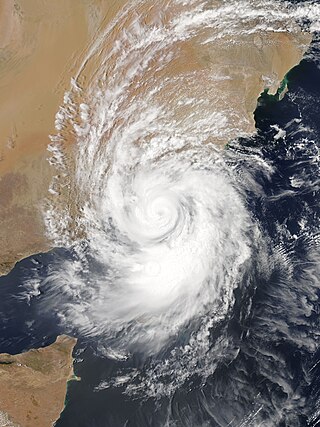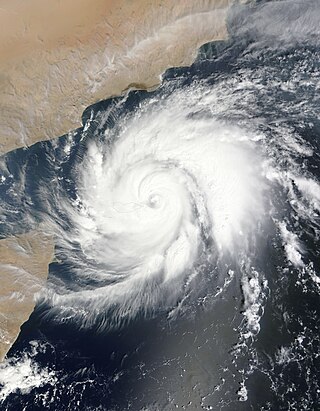
The United Arab Emirates is situated in the Middle East and West Asia, bordering the Gulf of Oman and the Persian Gulf, between Oman and Saudi Arabia; it is at a strategic location along the northern approaches to the Strait of Hormuz, a vital transit point for world crude oil. The UAE lies between 22°50′ and 26° north latitude and between 51° and 56°25′ east longitude. It shares a 19 km (12 mi) border with Qatar on the northwest, a 530 km (330 mi) border with Saudi Arabia on the west, south, and southeast, and a 450 km (280 mi) border with Oman on the southeast and northeast.
Karachi has a semi-arid climate, formerly a hot desert climate, albeit a moderate version of this climate, influenced by monsoons. Karachi has a tropical climate, despite being located slightly above the Tropic of Cancer. It is situated in the monsoon region of Pakistan. It is located on the coast bordering the Arabian Sea, and as a result, has a relatively mild climate. However, in more recent years, rainfall has become more abundant. For this reason, the city may be classed as semi-arid (BSh), since it has a mild climate with a short but defined wet season, along with a lengthy dry season.

Very Severe Cyclonic Storm Phet was a powerful tropical cyclone that made landfall on Oman, Western India, and Pakistan. The third named cyclone of the 2010 cyclone season, Phet developed in the Arabian Sea on May 31 to the west of India. With conducive environmental conditions, the storm intensified to reach peak sustained winds of 155 km/h (95 mph) on June 2, based on analysis by the India Meteorological Department (IMD). On the next day, Phet dropped heavy rainfall while moving across eastern Oman, with a peak of 603 mm (23.7 in) in Qurayyat. The rains flooded arid areas and collected into wadis – normally dry river beds. Thousands of homes were wrecked across Oman. There were 24 fatalities in the country, and damage was estimated at US$780 million.

Dubai features a tropical desert, hot arid climate. Dubai has two seasons – winter and summer. Rainfall has been increasing over the past few decades in the city accumulating to more than 130 mm (5.12 in) per year.

Cyclonic Storm Keila was the first named storm of the 2011 North Indian Ocean cyclone season. A weak system for much of its duration, Keila developed in the western Arabian Sea in late October 2011, amid an area of marginally favorable conditions. On November 2, it briefly organized enough to be classified as a cyclonic storm, which has maximum sustained winds of at least 65 km/h (40 mph). Given the name Keila by the India Meteorological Department (IMD), the storm quickly moved ashore southern Oman near Salalah, and weakened while meandering over the country. The remnants soon after moved offshore, dissipating on November 4.

The 2015 North Indian Ocean cyclone season was an event in the annual cycle of tropical cyclone formation. The North Indian Ocean cyclone season has no official bounds, but cyclones tend to form between months of April and December, with the peak from May to November. These dates conventionally delimit the period of each year when most tropical cyclones form in the northern Indian Ocean.

Tropical Storm Kujira was a tropical cyclone that prompted the PAGASA to declare the beginning of the rainy season in the Philippines. The ninth tropical depression, 8th named storm, and first storm to make landfall on China in the 2015 Pacific typhoon season, it formed as a tropical depression south of the Paracel Islands on June 19.

The 2018 North Indian Ocean cyclone season was one of the most active North Indian Ocean cyclone seasons since 1992, with the formation of fourteen depressions and seven cyclones. The North Indian Ocean cyclone season has no official bounds, but cyclones tend to form between April and December, with the two peaks in May and November. These dates conventionally delimit the period of each year when most tropical cyclones form in the northern Indian Ocean.

The 2019 North Indian Ocean cyclone season was the second most active North Indian Ocean cyclone season on record in terms of cyclonic storms, the 1992 season was more active according to the Joint Typhoon Warning Center. The season featured 12 depressions, 11 deep depressions, 8 cyclonic storms, 6 severe cyclonic storms, 6 very severe cyclonic storms, 3 extremely severe cyclonic storms, and 1 super cyclonic storm, Kyarr, the first since Cyclone Gonu in 2007. Additionally, it also became the third-costliest season recorded in the North Indian Ocean, only behind the 2020 and 2008 seasons.

Extremely Severe Cyclonic Storm Mekunu was the strongest storm to strike Oman's Dhofar Governorate since 1959. The second named storm of the 2018 North Indian Ocean cyclone season, Mekunu developed out of a low-pressure area on May 21. It gradually intensified, passing east of Socotra on May 23 as a very intense tropical cyclone. On May 25, Mekunu reached its peak intensity. The India Meteorological Department estimated 10 minute sustained winds of 175 km/h (110 mph), making Mekunu an extremely severe cyclonic storm. The American-based Joint Typhoon Warning Center estimated slightly higher 1 minute winds of 185 km/h (115 mph). While at peak intensity, Mekunu made landfall near Raysut, Oman, on May 25. The storm rapidly weakened over land, dissipating on May 27.

The 2021 North Indian Ocean cyclone season was an average season, the North Indian Ocean cyclone season has no official bounds, but cyclones tend to form between April and December, peaking between May and November. These dates conventionally delimit the period of each year when most tropical cyclones form in the northern Indian Ocean. The season began on April 2, when a depression designated as BOB 01 was formed in the north Andaman Sea and quickly made landfall in Myanmar. The basin remained quiet for over a month before Cyclone Tauktae formed. It rapidly intensified into an extremely severe cyclonic storm before making landfall in Gujarat, become the strongest storm ever to strike that state since the 1998 Gujarat cyclone. Later that month, BOB 02 formed and later strengthened into Cyclone Yaas. Yaas rapidly intensified into a very severe cyclonic storm before making landfall in northwestern Odisha. The season's strongest tropical cyclone was Cyclone Tauktae, with maximum wind speeds of 185 km/h (115 mph) and a minimum barometric pressure of 950 hPa (28.05 inHg).

Super Cyclonic Storm Kyarr was an extremely powerful tropical cyclone that became the first super cyclonic storm in the North Indian Ocean since Gonu in 2007. It was also the second strongest tropical cyclone in the Arabian Sea and one of the most intense tropical cyclones in North Indian Ocean history. The seventh depression, fifth named cyclone, and the first, and only Super Cyclonic Storm of the annual season, Kyarr developed from a low-pressure system near the Equator. The system organized itself and intensified to a tropical storm on October 24 as it moved eastwards. The storm underwent rapid intensification and reached Super Cyclonic Storm status on October 27, as it turned westward. On that same day, Kyarr peaked as a Super Cyclonic Storm, with maximum 3-minute sustained winds of 240 km/h (150 mph), maximum 1-minute sustained winds of 250 km/h (155 mph), and a minimum central pressure of 922 millibars (27.2 inHg), making the system a high-end Category 4-equivalent tropical cyclone. Afterward, Kyarr gradually began to weaken, while curving westward, and then turning to the southwest. On October 31, Kyarr weakened into a Deep Depression, before turning southward on November 2, passing just to the west of Socotra. Kyarr degenerated into a remnant low later that day, before dissipating on November 3, just off the coast of Somalia.

Cloud seeding in the United Arab Emirates is a weather modification technique used by the government to address water challenges in the country. Cloud seeding is also referred to as man made precipitation and artificial rain making. The United Arab Emirates is one of the first countries in the Persian Gulf region to use cloud seeding technology. UAE scientists use cloud seeding technology to supplement the country's water insecurity, which stems from the extremely hot climate. They use weather radars to continuously monitor the atmosphere of the country. Forecasters and scientists have estimated that cloud seeding operations can enhance rainfall by as much as 30-35% percent in a clear atmosphere, and up to 10-15% in a more humid atmosphere. This practice has caused concerns regarding the impact on the environment because it is difficult to predict the long-term global implications.

Cyclonic Storm Gulab and Severe Cyclonic Storm Shaheen were two tropical cyclones that caused considerable damage to South and West Asia during the 2021 North Indian Ocean cyclone season. Gulab impacted India and Pakistan, while Shaheen impacted Iran, Oman and the United Arab Emirates. Gulab was the third named storm of the 2021 North Indian Ocean cyclone season, as well as the fourth named storm of the season after its reformation in the Arabian Sea as Shaheen. The cyclone's origins can be traced back to a low-pressure area situated over the Bay of Bengal on September 24. The Pakistan Meteorological Department named this new cyclone Gulab.On September 26, Gulab made landfall in India's Andhra Pradesh but weakened overland, before degenerating into a remnant low on September 28. The system continued moving westward, emerging into the Arabian Sea on September 29, before regenerating into a depression early on September 30. Early on October 1, the system restrengthened into a Cyclonic Storm, which the IMD named Shaheen. The system gradually strengthened as it entered the Gulf of Oman. While slowly moving westward, the storm turned southwestward, subsequently making an extremely rare landfall in Oman on October 3, as a Category 1-equivalent cyclone. Shaheen then rapidly weakened, before dissipating the next day.
In 2022, heavy rains caused floods in the United Arab Emirates, lasting from 27 to 29 July 2022. Cities of the northern Emirates, mainly Kalba and Fujairah, and different areas of the Emirate of Ras Al Khaimah, were affected by the heavy rains. According to the Emirati National Center for Meteorology, this was the country's heaviest rainfall recorded in 27 years.

Extremely Severe Cyclonic Storm Tej was a strong tropical cyclone that formed over the central-south Arabian Sea and made landfall on Yemen. It was the first cyclone to make landfall in the nation since Cyclone Luban of 2018. The sixth depression and the third named cyclonic storm of the season, Tej coexisted with Cyclone Hamoon in the Bay of Bengal, a rare phenomenon not seen since 2018. The cyclone then took a northwestward track in the Arabian Sea and made landfall in Al Mahrah Governorate of Yemen between 23 and 24 October 2023, bringing significant rainfall and flooding across the eastern half of the country and western parts of Oman.
Events in the year 2024 in the United Arab Emirates.
Since 12 April 2024, heavy rains, lightning, and flash flooding in both Afghanistan and Pakistan killed more than 130, and injured many more. The floods were caused by unseasonal heavy rains, lightning and storms that swept across the two neighboring countries. The floods caused extensive damage to infrastructure and agriculture on both sides of the border.

On 16 April 2024, heavy rains caused floods in the United Arab Emirates, affected cities of mainly Dubai and Sharjah, the northern Emirates, and different areas of the Emirate of Ras Al Khaimah. According to the Emirati National Center for Meteorology, this was the country's heaviest rainfall recorded in 75 years. The floods in the Emirates were a part of the greater Persian Gulf floods.


















